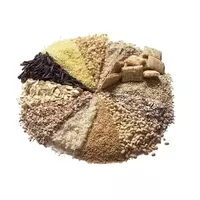Cereals

Many people think about the unique beneficial properties of cereals, as well as the importance of these plant species for agriculture, as well as for the entire human civilization as a whole. According to their biological structure and basic properties, cereals or Gramíneae belong to the family of so-called monocotyledonous plants. In scientific literature, cereal crops are often ranked among the Myatlikov family.
Types of cereals
At present, science knows a fairly large number of cereal species. The Zlakov family is divided into more than 700 genera, in which 11 thousand plant species are eaten. However, among the most widespread and widely known types of cereals, perhaps such as wheat, rice, barley, rye, oats, corn, as well as simple, sugarcane and bamboo can be distinguished. All of the above types of cereal plants play an important role in the food industry of all world states without exception.
Composition of cereals
It is worth noting that cereal crops can grow in a variety of climatic conditions and ecosystems. According to scientific research, cereals are found even in the harsh climate of Antarctica. This speaks to the unique properties of cereals, which have shown themselves to be climate-resistant plants. As a rule, the chemical composition of cereals is enriched with a significant amount of useful and even indispensable compounds for the human body.
Due to the unique natural composition, cereals have a beneficial effect on the human body. For this reason, many cereal crops have long been used in folk decim as an effective therapeutic and preventive agent in the fight against various ailments and diseases. People actively use the benefits of cereals in our time.
The Benefits of Cereals
Cereal crops are used in writing, and are also used as feed plants. In addition, cereals exhibit their beneficial properties in the pharmacological as well as cosmetic spheres. Cereals benefit people of various ages, so doctors and nutritionists strongly recommend eating foods made from cereal plants as often as possible. Usually, the calorie content of cereals is at a fairly high level.
This state of affairs is primarily associated with the chemical composition of plants. The average caloric content of varnishes reaches 293 Kcal, which are contained in 100 grams of the plant. Cereals contain a large amount of carbohydrates that saturate the human body with energy. Cereals are enriched with plant protein, which is quickly absorbed by the human body and contains essential amino acids and other compounds useful for humans.
Harm to cereals
True, in addition to the benefits, there is also the harm of cereals, which can manifest itself in several main cases. First of all, cereals are harmed by improper or excessive consumption of cereal products for food. Do not get carried away with cereal products for people who suffer from some types of diseases of the gastrointestinal tract.
cereals 293 kCal
Energy value of cereals (Ratio of proteins, fats, carbohydrates - ju):
Proteins: 12.8 g (~ 51 kCal)
Fats: 2.08 (~ 19 kCal)
Carbohydrates: 54.5g (~ 218 kCal)
Energy ratio (b | y): 17% | 6% | 74%
 Español
Español Français
Français Português
Português Русский
Русский 简体中文
简体中文 繁體中文
繁體中文 日本語
日本語 한국어
한국어 العربية
العربية Türkçe
Türkçe Қазақ
Қазақ Deutsch
Deutsch Italiano
Italiano Українська
Українська
